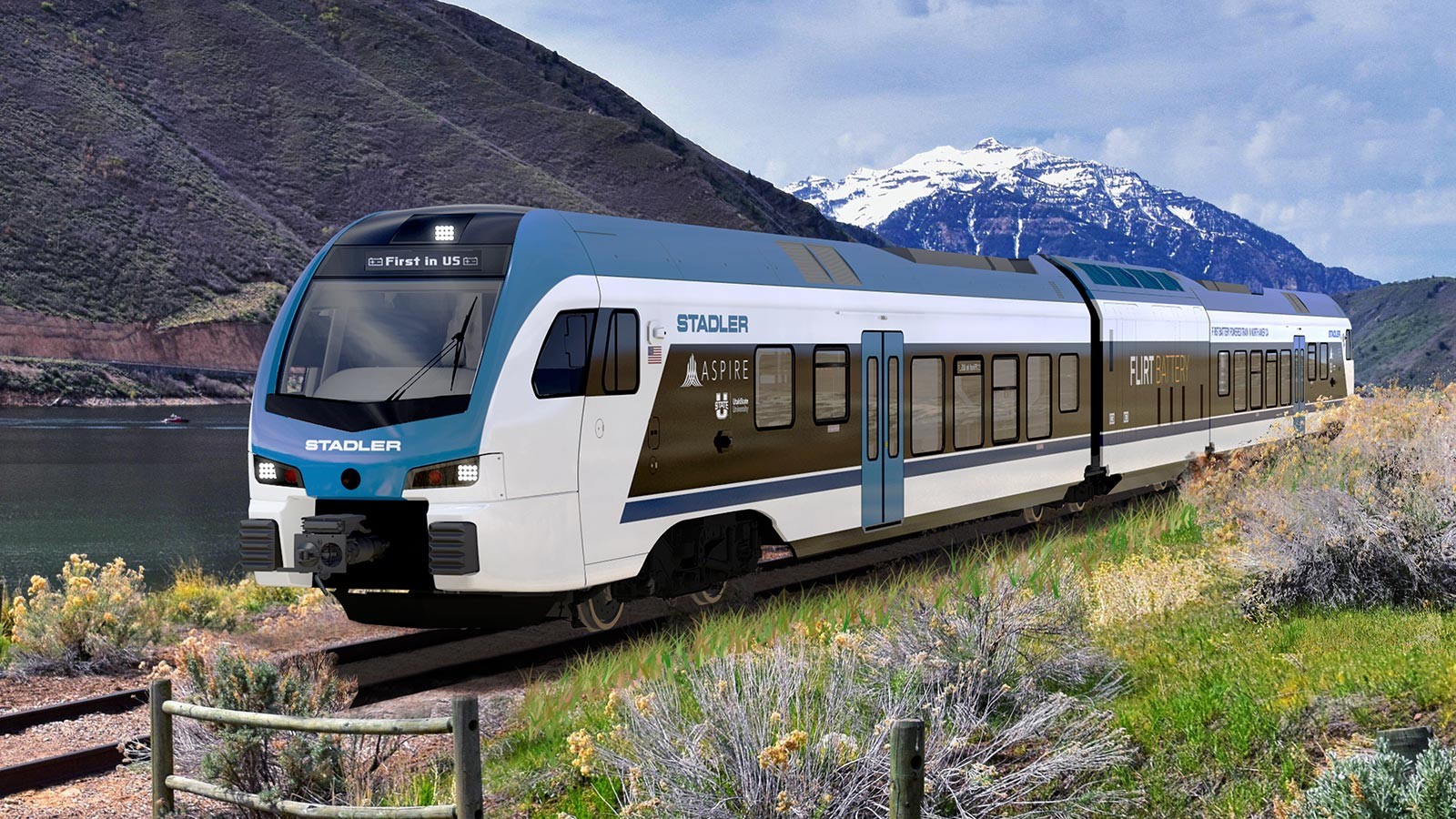Partnership Between USU and Stadler Brings Battery-Powered Trains to North America
By Sydney Dahle |
This rendering shows the FLIRT battery train, in development by Stadler US, Inc., and USU's ASPIRE Engineering Research Center.
Utah State University and the ASPIRE Engineering Research Center will partner with Swiss-based Stadler to develop and test a battery-powered passenger train known as FLIRT. This train will be the first of its kind in North America.
The goal of the project is to develop and build a battery-powered two-car-trainset. The Battery FLIRT, a single-decker, lightweight train, is the solution for routes without end-to-end overhead electric infrastructure, enabling emission-free travel and allowing for longer routes.
The collaboration between ASPIRE and Stadler is planned to provide a model to demonstrate Stadler’s zero-emission capabilities in real life. While Stadler’s focus is on the design and build of the trainset itself, ASPIRE will focus on charging infrastructure, workforce development and potential impact in Utah. Tests are planned to take place at Stadler’s facility in Salt Lake City.
“We are honored to partner with Stadler on this groundbreaking project. Success will bring design and manufacturing jobs to Utah. It will also chart the path to electrified commuter and light rail systems along the Wasatch Front,” said Regan Zane, director of the NSF ASPIRE Engineering Research Center. “The battery-electric train solution will improve air quality and reduce operating costs while supporting shared charging infrastructure with trucks, buses and cars. We’re beyond pleased to have such an incredible opportunity to be working with a world-class manufacturer here in the state.”
ASPIRE was awarded legislative funding to help achieve three goals with this technology: workforce development, economic impact and improving air quality. The battery FLIRT model will be similar to the diesel and electric versions and can be tailored according to customers’ needs.
“The Utah Legislature is committed to developing strong public-private partnerships like this that result in innovative solutions to critical issues facing our state. We are thrilled to be partners in this project and look forward to its success,” said Mike Schultz, majority leader of the Utah House of Representatives.
Stadler currently has contracts for battery trains for Germany. Diesel FLIRT from Stadler are already operating in Texas for Texrail and in California for SBCTA. However, this is Stadler’s first time introducing the battery FLIRT to the US market, which requires expansive research and development to adapt the vehicle for U.S. infrastructure and regulations.
“With little to no electrified routes in the North American public rail transit system, a battery train is a great zero-emission alternative to diesel-powered vehicles. After a contract for a hydrogen-powered FLIRT for California, we are now excited to bring a battery solution to the United States to add to our zero-emission product line,” said Martin Ritter, CEO of Stadler US, Inc. “In ASPIRE we have found an excellent partner to develop the most efficient and fully integrated system for environmentally friendly mobility. We are proud to be able to work with local talent to design and build this technology here in Utah.”
About Stadler
Stadler has been building trains for 80 years. The provider of rail vehicle construction solutions has its headquarters in Bussnang in eastern Switzerland. It has a workforce of over 13,000 based in various production and engineering locations as well as more than 70 service locations. The company is conscious of its social responsibility for sustainable mobility and therefore stands for innovative, sustainable and durable quality products. The product range in the field of mainline railways and city transport includes high-speed trains, intercity trains, regional and suburban trains, metros, tramways and trams. Stadler also manufactures main-line locomotives, shunting locomotives and passenger carriages. It is the world’s leading manufacturer in the rack-and-pinion rail vehicle industry.
About ASPIRE
The ASPIRE Engineering Research Center was launched in September 2020 with a 10-year, $50 million grant from the National Science Foundation with its main purpose to support widespread adoption of electrified transportation through developing technologies and clearing barriers leading to low cost, ubiquitous charging infrastructure. A key aspect of the ASPIRE research portfolio is dynamic wireless power transfer, a research and development area where ASPIRE’s partner universities have led advances for many years. The ASPIRE university partners (Utah State University, Purdue University, University of Colorado Boulder, University of Texas at El Paso, and University of Auckland, New Zealand) are joined by more than 60 industry, government and non-profit members from all sectors of the electric transportation ecosystem.
For more information, visit aspire.usu.edu.
WRITER
Sydney Dahle
Public Relations Specialist
College of Engineering
435-797-7512
sydney.dahle@usu.edu
CONTACT
Sydney Dahle
Public Relations Specialist
College of Engineering
435-797-7512
sydney.dahle@usu.edu
Charlotte Thalhammer
Marketing and Communication Manager
Stadler US, Inc.
385-394-1921
charlotte.thalhammer@stadlerrail.com
TOPICS
Engineering 336stories Environment 263stories Technology 139storiesComments and questions regarding this article may be directed to the contact person listed on this page.







